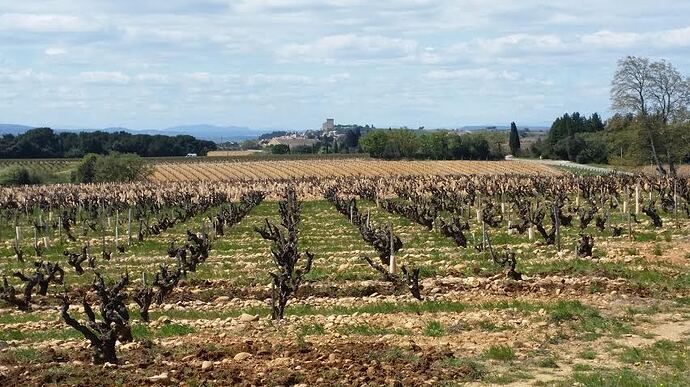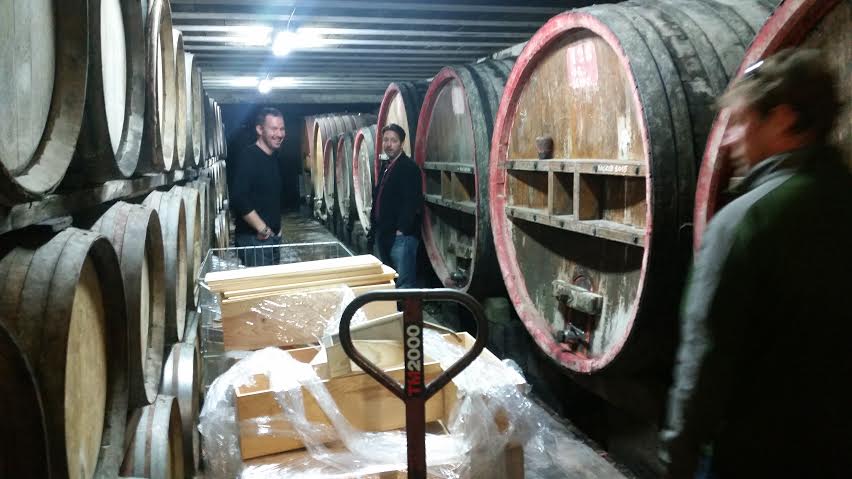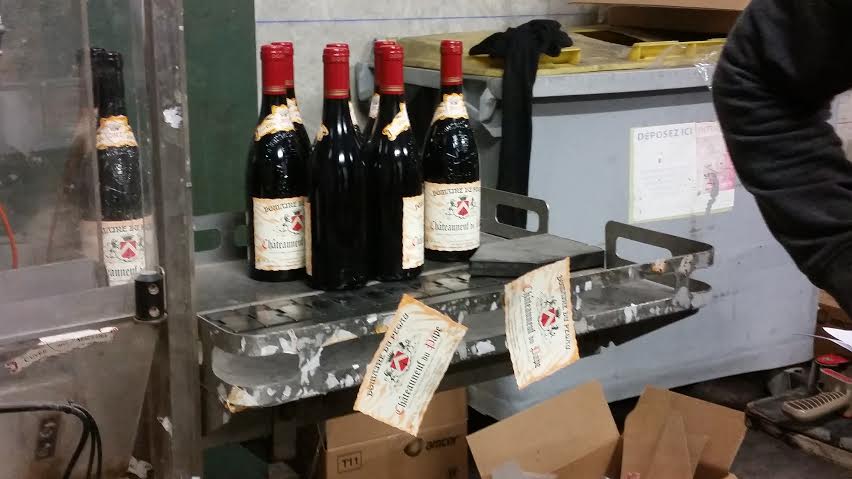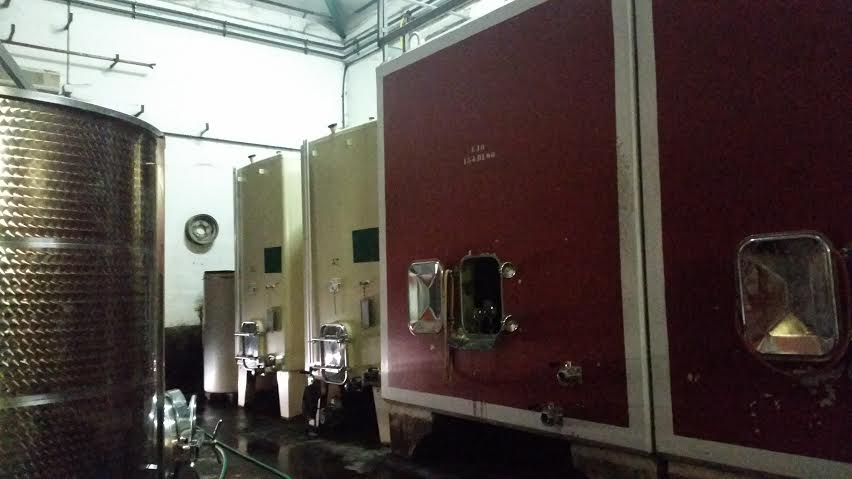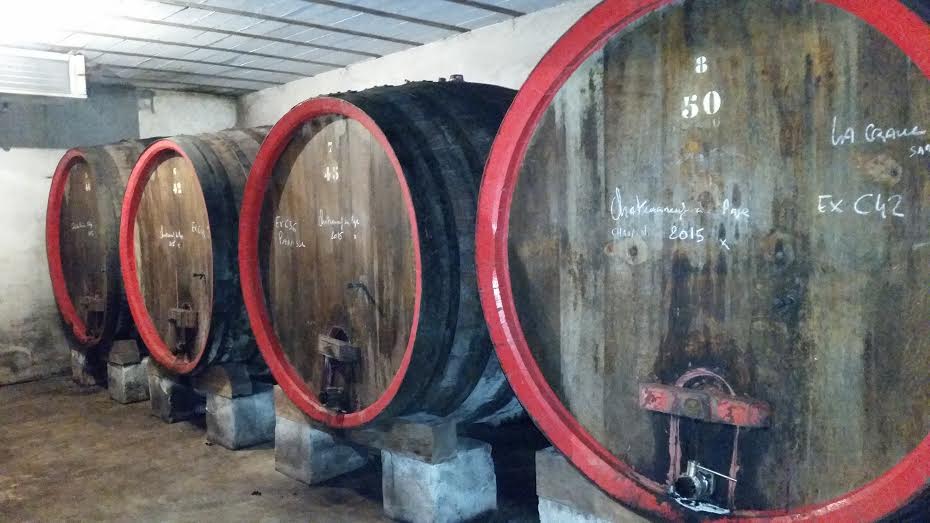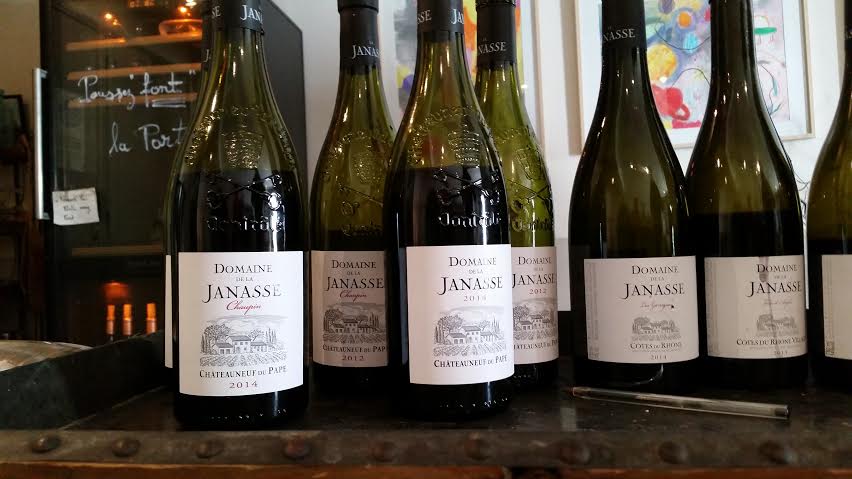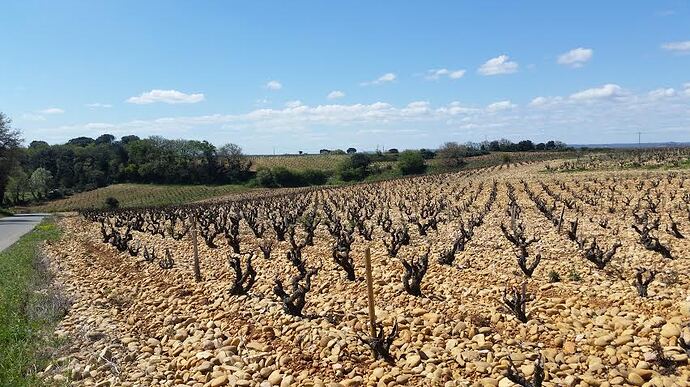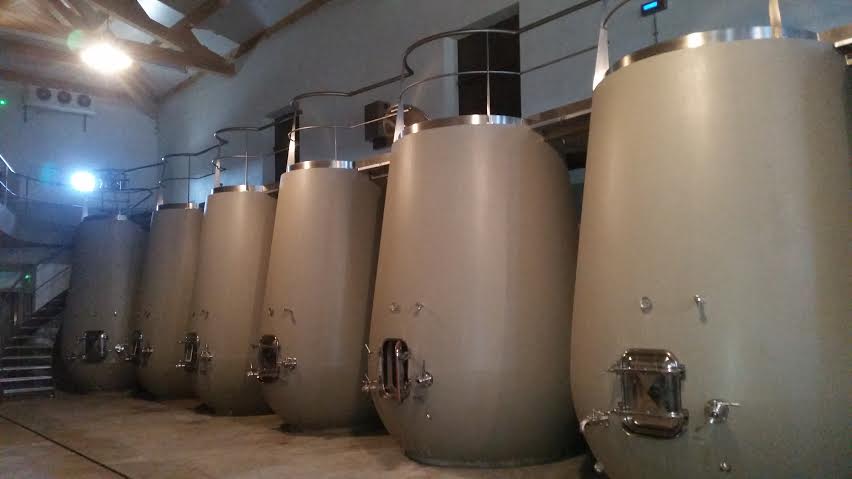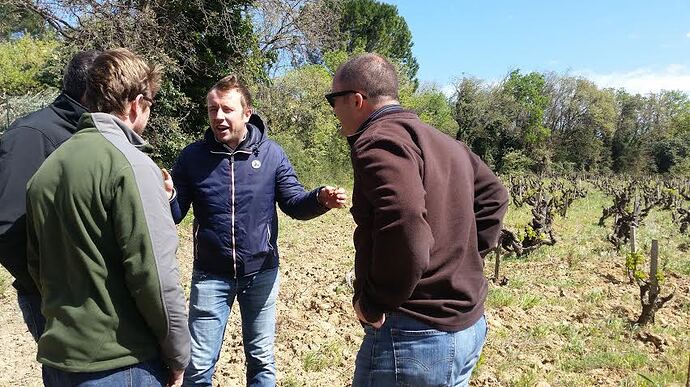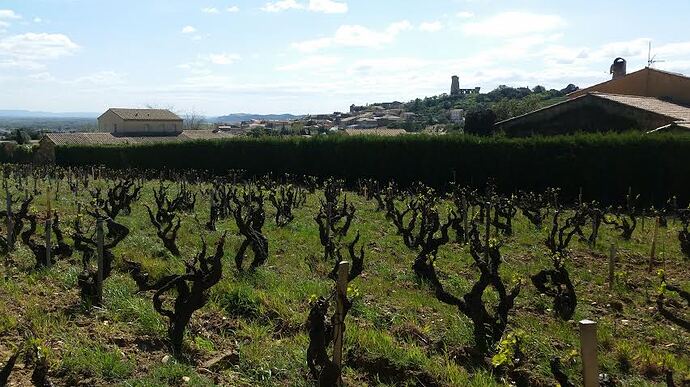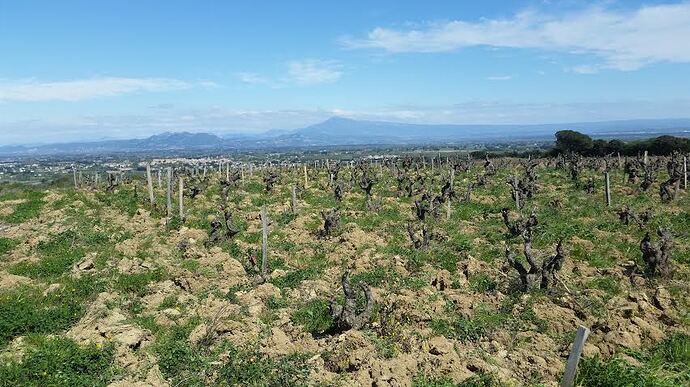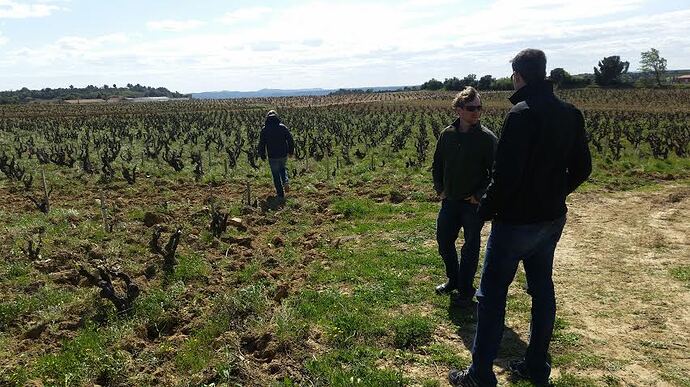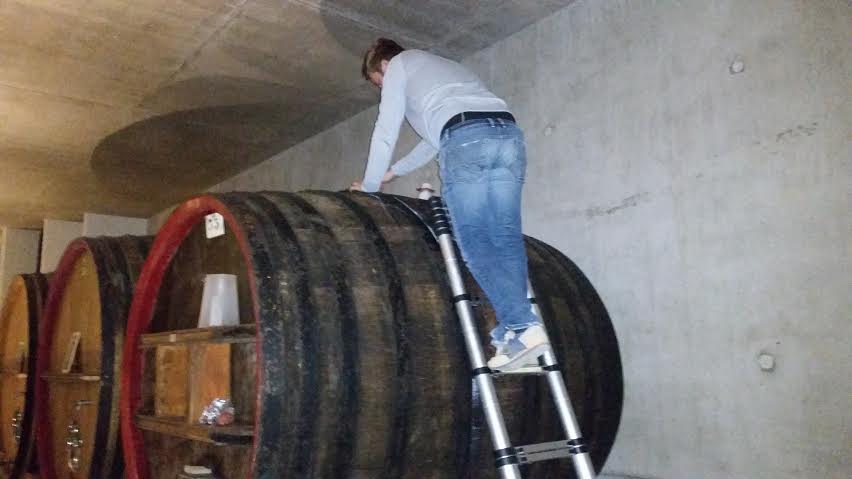Below is the last of my write-ups from my Rhône/Burgundy visits in April. I did this mainly for my friends I was traveling with, but thought some might enjoy here. Cellartracker notes for the wines I tasted below are grouped together- Chateauneuf-Du-Pape domaine visits - CellarTracker. Cheers!
(Looking west toward the village)
On the flipside of a bright and sunny early April day in Châteauneuf-du-Pape, were the whipping cold Mistral winds. The vines were just on the other side of bud break, and the heat of the Mediterranean summer was far in the distance. My wife Melissa and my wine-touring friends Justin and Jon set off for the last of our wine adventures during our early spring visit to France. This day would feature visits to venerable producers and top vineyard sites in Châteauneuf-du-Pape, along with sensational wines.
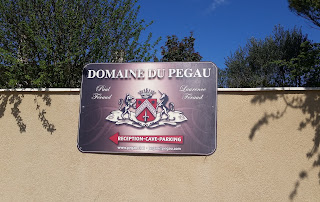
The highlights started early, at Domaine-du-Pegaü. Pegaü is a top-echelon producer of Châteauneuf-du-Pape, along with other wines of the Southern Rhône. The proprietors are the Feraud family, whose history of agriculture in the area dates back centuries, and with winemaking as far back as 1733. It was 1987 however that Laurence Feraud and her father Paul Feraud created the domain in its modern form.
Today, they own 21 hectares in the AOC, spread across several different terroirs. La Crau to the east of the village- planted to 13 different varieties, with 100+ year old vines planted on sandy & pebbly soils. The Bédarrides area- 75 year-old Grenache vines grown in pebbly soil, with south and southeast exposures. The Châteauneuf-du-Pape village area- parcels growing Grenache and Mourvedre in red earth and pebbly soil, and parcels growing Grenache Blanc, Clairette, Bourboulenc, and Roussanne in clay soils. The Pignan in the north of the appellation- low yielding Grenache and Mourvedre planted on a hilltop near Chateau Rayas, protected from Le Mistral winds by the surrounding forest, and with soils similar to La Crau. And Les Bosquets- near the domaine, 80 year-old vines planted to Grenache, Cinsault, Counoise and others, on hillsides sheltered from Le Mistral and overlooking the Rhône. Pegaü also bottles Côtes-du-Rhône and Côtes-du-Rhône Villages under the Chateau Pegaü label from grapes grown outside of the Châteauneuf-du-Pape AOC.
In the cellar, the wines are made in a very traditional manner, particularly the reds. The Châteauneuf-du-Pape’s are fermented using whole bunches, in concrete, and with no added yeast or sulfur. Aging takes place primarily in 100-year-old Russian oak casks, with extended elevage and stricter selection of grapes on the top bottlings. The Cuvée Réservée receives 18-24 months of aging, and is typically around 80% Grenache, 6% Syrah, 4% Mourvedre, with the other 10% coming from the remaining varieties allowed in the appellation. The Cuvée Laurence comes from a single cask that is selected for extended aging, usually an additional 2 years longer than the 18-24 months that the Cuvée Réservée receives. The Cuvée de Capo is the domain’s most exclusive bottling, and is the strictest vineyard and tank selection, made only the top vintages, and is matured for 27 months. The Châteauneuf-du-Pape Blancs are fermented in concrete egg, typically 60% Clairette, 20% Grenache Blanc, 10% Roussanne and 10% Bourboulenc, aged without malolactic fermentation in stainless steel tanks.
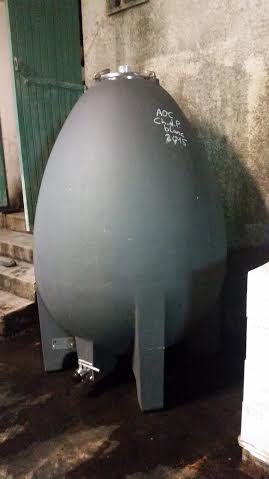
Our tasting included a range of Château Pegaü wines, highlighted by the 2015 Château Pegaü Côtes du Rhône Blanc Cuvée Lone (Clairette, Bourboulenc, Grenache Blanc & Ugni Blanc) showing well-balanced citrus zest, honeysuckle flowers, minerality and white pepper; the 2015 Château Pegaü Vin de France Pink Pegaü Rosé (100% Cinsault) showing white flowers, minerality, zesty berry fruit and peppery spice; and the 2013 Château Pegaü Côtes du Rhône Villages Cuveé Setier (Grenache/Syrah/Mourvedre) showing black fruit, spice and florals with nice richness and depth.
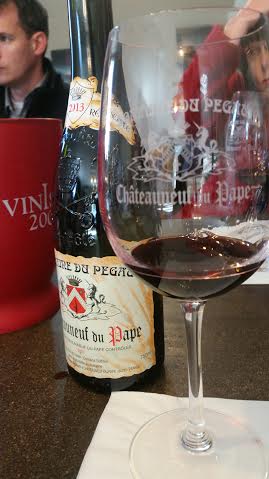
Two Domaine Du Pegaü wines were shown. The 2013 Châteauneuf-du-Pape Cuvée Reservée wowed with aromas of spices, garrigue, cassis, cherry & violets; with great concentration and intensity on the palate, balanced with silky elegance; finishing with thick, firm and silky tannins and hints of mineral notes. The 2011 Châteauneuf-du-Pape Cuvée Laurence was even more expressive- showing minerality, garrigue, meat, leather, tobacco, anise and blackberry; concentrated, silky and complex on the palate with silky tannins and a huge finish. Two incredibly complex and profound wines.
The second stop, Domaine De La Janasse, is located in the village of Courthezon in the northwest of the Châteauneuf-Du-Pape appellation. The domain was founded in 1967 by Aimé Sabon, who took over his father’s vines upon returning from military service. Today, the wines are made by the second generation, Christophe and Isabelle Sabon.
Domaine De La Janasse grows each of the 13 permitted varietals of the appellation, including plots in La Crau. They prefer Grenache coming from the cooler, northern parts of the appellation, with rockier soils; Syrah and white varieties from sandy limestone soils with eastern exposures; and Mourvedre coming from clay and limestone soils covered with river rocks. Farming is free of herbicides and pesticides, and makes use of natural fertilizers.
(Mourvedre and Syrah aging in barrique at Janasse)
Winemaking is more pragmatic than Pegaü. Grapes are sorted in the vineyard and again in the cellar. For the Châteauneuf-du-Pape red cuvees, wines are partially destemmed, the degree of which depends on the ripeness of the stems. The wines are cold-soaked, with a daily manual punch-down for gentle extraction of tannins. Grenache is matured in large French oak foudres to allow for a slower micro-oxygenation, while Syrah and Mourvedre are aged in smaller French oak barrels in order to soften tannins. Typical aging is 12-14 months. The white Châteauneuf-Du-Pape wines make use of mostly new barrel fermentation for Roussanne, and vat fermentation for Grenache Blanc and Clairette, and are bottled unfiltered. The Côtes-Du-Rhône and Côtes-Du-Rhône Villages range of wines are grown in Courthezon just outside of the appellation. Grenache, Mourvedre, Syrah and Carignane are the primary reds; and Grenache Blanc, Clairette, Bourboulenc, Viognier and Roussanne are primary whites. The reds are made with less stem inclusion, with the Côtes-Du-Rhône wines being aged in concrete vats and the Côtes-Du-Rhône Villages wines being aged in foudre and barrel, much like the Châteauneuf-Du-Pape reds.
(Grenache aging in foudres in the cellar at Janasse)
Our visit included a cellar tour and a tasting of the full range of the domain’s wines. The Côtes-Du-Rhône reds impressed, particularly the richness and depth of the 2013 Côtes-du-Rhône Villages Terre d’Argile. The 2013 Châteauneuf-du-Pape Blanc was very impressive, showing expressive notes of clove, butterscotch, stone fruit and white flowers; with silky structure, layered complexity, and full length on the finish.
A trio of the domain’s 2012 Châteauneuf-du-Pape reds were shown, as were 2 recently bottled 2014’s. All were extremely solid- The two standouts being the 2012 Châteauneuf-du-Pape, showing aromas of brambly black fruit, mineral and fresh flowers; with bright red fruit on the palate and rich, silky layers of spice and minerality; along a rich and dense core and full finish. The 2012 Châteauneuf-du-Pape Vieilles Vignes showing greater complexity with aromas of sandalwood, fig, spice, flowers and cherry; leading to silky fig and cherry fruit on the palate, layered with spice and earth complexity; with silky tannins through a big and dense core, and a huge finish.
(Les Tresquous terroir, looking southwest)
Domaine La Barroche is located in the village of Châteauneuf-du-Pape. The Barrot family’s history in the village dates back to 1703, with vineyard plots first being developed in the late 19th Century. Christian Barrot further expanded the domain’s vineyard holdings in the 1970’s, focusing on new plots in different terroirs, while lowering yields and increasing quality. He sold wine produced from the plots in bulk to prestigious negociants in the Rhône. In the early 2000’s Christian’s children, Julien and Laetitia, were brought in as the domaine set out to bottle and sell its own wine. Today, Julien farms and makes the wine, and Laetitia runs the sales and communication.
(new concrete fermenters at Barroche)
Inside the gate of the new winery facility, we were greeted by a gregarious and rugged fellow who turned out to be Julien. Julien exuded enthusiasm as he quickly showed us the inside of the ultra-modern gravity-flow winery and its new concrete tanks. He asked us how much time we had, and if we’d like to see the domain’s vineyard plots throughout Châteauneuf-du-Pape. And with that, we were off in my rental car bouncing around gravel drives through the vineyards, with Julien behind the wheel.
(both of these- I believe we are in Les Bosquet vineyard plots of Barroche)
As we drove, Julien explained that he typically favors soils with less limestone in the topsoil, and more sand, clay and iron-rich sandstone, which to him expresses the purity he’s looking for in Grenache. He explained that he practices biodynamic farming, although he’s skeptical of some of the various rituals therein.
(Terres Blanches plots of Barroche, looking east)
At the various vineyard stops, Julien explained the variances in the soils, often times atypical of the given lieux-dit in which they are located. For instance, at the first stop in the section of the Les Bosquets area nearest to the village, the field blend of 100+ year old Grenache, Mourvedre, and Clairette vines is on less-rocky soil than further up the hill. Stopping in the Terres Blanches area up the slope north of the village, we saw Barrot’s Grenache vines growing on sandy soils surrounded by vineyards covered with river rocks.
(Grand Pierre plots of Barroche, looking west)
(Grand Pierre plots of Barroche, looking north)
At the crest of the Rayas slope, with Le Mistral winds whipping around us, we toured Barrot’s plots in Grand Pierre. Soils here were sandy, with iron-rich red sandstone. From there, we circled north and east past Barrot’s plots in Cabrières looking west toward the Rhône, and then back to the village and the winery. While driving, Julien explained that while he could make very intellectually appealing and distinctive wines from individual plots, he preferred the wholeness and completeness of the wines he’s able to craft from the plots as a whole.
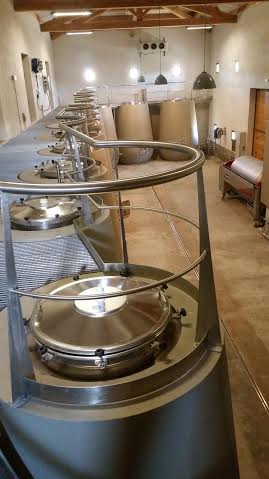
(Barroche- looking into the tank room from the crush pad)
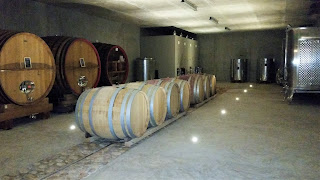
(The barrel room below)
As the winery is built into the side of the hill, we entered the tank room from the top level where the grapes are brought in, seeing the tops of the new concrete tanks, then descending two levels down into the barrel room for tasting. The production at La Barroche is solely red Châteauneuf-du-Pape cuvees. The grapes are fermented in concrete tanks, with destemming of underripe stalks, with gentle extended macerations. Grenache is aged in old oak casks, while Syrah and Mourvedre are aged in 600L French oak barrels, and Cinsault is aged in stainless steel tanks. Aging is approximately 18 months, and the wines are bottled unfiltered.
(sampling 2015 Grenache)
Our tasting included 2015 Grenache from cask, including the blend for the 2015 Châteauneuf-du-Pape Pure (the domain’s predominately Grenache cuvee from its top vineyard sites)- which showed concentrated and complex notes of blackberry compote, fig, cracked pepper, flowers, minerals and spices- rich, spicy, dense and powerful on the palate, with creamy silky tannins and a huge finish. The 2015 Mourvedre and Syrah from barrel both showed huge concentration and depth.
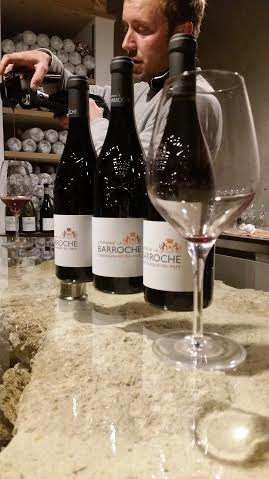
Bottled wines tasted in included the 2014 Chateauneuf-du-Pape Pure; a 2013, 2012, 2011 vertical of the domain’s standard Châteauneuf-du-Pape; and a 2005 Châteauneuf-du-Pape Fiancée. The 2014 Pure showed beautiful primary raspberry and lavender notes, with garrigue, black tea and clove, along an elegant yet dense palate with great depth and length. The vertical of the domain’s Châteauneuf-du-Pape cuvee showed primary red fruit, minerality and flowers of 2013, sweet red fruit, spices and flowers of 2012, and a great balance of ripe red fruit, minerality, garrigue, spices and tobacco in 2011. All were richly layered with silky elegant tannins. It’s tough to pick a favorite of the three- but the complexity of the 2012 stood out- notes of fig paste, allspice berry, rose hips, raspberry, tea and lavender- with silky rich layers, great density & texture, thick silky tannins, and great length. The 2005 Fiancée is a Grenache and Syrah blend that Barrot is no longer producing. It showed nice complexity of red fruit and spices, with silky structure and some nice minerality on the palate- still very youthful. Overall, I thought Barrot’s wines displayed an impressive precision and purity of flavor, while capturing the earthy mineral and garrigue notes that are endearing in Châteauneuf-du-Pape.
It was a truly amazing day experiencing the terroir in Châteuneuf-Du-Pape. With that, it was farewell to the majestic Rhône Valley.
Here’s a great map of the vineyards of CdP- Lieux-dits
